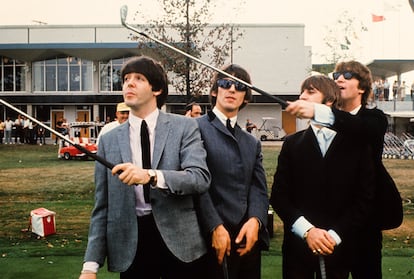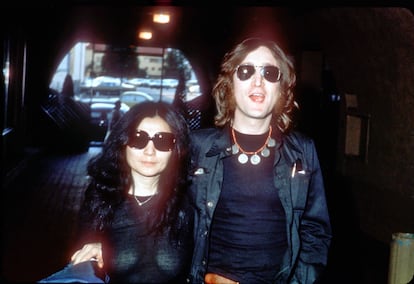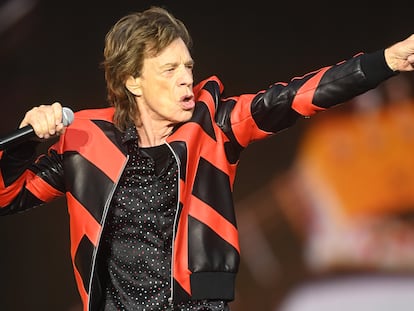The new Beatles song ‘Now and Then’ was produced with the help of artificial intelligence: The history and controversies surrounding the tune now that we’ve finally heard it
Specialists discuss the role of AI in the quality, appropriateness and contributions on the track just released by the most profitable brand in rock history

In this bewildering world we live in, there’s a surprise around every corner, and so little fazes us these days. But maybe this news will make us sit up and take notice: there’s a new Beatles song in 2023! Let’s remember: the group broke up 53 years ago, and two of its four members have already passed away. But in the new song, you can hear John Lennon’s voice as he plays his white piano at the Dakota Building: “I know it’s true, it’s all because of you / And if I make it, it’s because of you. / And once in a while, if we have to start over, we’ll know for sure that I love you.”
The story of Now and Then, which can be heard since this Thursday and which Paul McCartney has described as “the Beatles’ final song,” touches on too many issues to remain confined to the 4 minutes and 8 seconds that the Jealous Guy ballad lasts (this is not a comparison, just an example). The Beatles are the most important group in history; and there is no greater bugaboo for rock purists than the evil of artificial intelligence (AI). It has caused such a controversy that, for a few days now, the many press releases on the Liverpool quartet’s new song have refrained from mentioning AI, which Paul McCartney did cite last June when he first broke the news about the song on BBC Radio 4. “Paul McCartney says artificial intelligence has enabled a final Beatles song,” the BBC headline read.
Five months later, Now and Then can now be heard, and it will be hard to prove whether everything Lennon sings comes from him or AI. “His voice sounds perfect, it’s very good. I think Lennon is very recognizable. Sometimes it sounds like his son... But yes, I recognize John’s voice,” musician Igor Paskual observes after listening to Now and Then. The official statement says that technology has not been used to artificially create Lennon’s voice, but rather “to preserve the clarity and integrity of the original vocal performance by separating it from the piano.” In other words, AI served to iron out and clean up sounds, not to create them. After that, there were additions made in 2023: McCartney, 81, contributed bass and piano, and Starr, 83, played the drums; guitar has been recovered from Harrison (who died in 2001) and backup vocals have been added. In addition, McCartney has recorded some slide guitar sketches “in George’s style” and Giles Martin, the son of producer and “fifth Beatle” George Martin (who died in 2016), wrote a string arrangement. It’s technological surgery that has made purist fans squirm.
Now and Then is a piece from the late 1970s, recorded on piano and voiced by a thirty-something Lennon in some room of New York’s Dakota building, where the Beatle lived with his partner, Yoko Ono, (and where he was killed at age 40 on December 8, 1980, by Mark David Chapman). Thus, the song originated with Lennon. In the mid-1990s, Paul, Ringo and George asked Yoko Ono if she had any Lennon material squirreled away. Ono offered them three tracks her partner had been working on: Free As a Bird, Real Love and Now and Then. It was a homemade cassette tape on which John (presumably) had written: “For Paul.” Theories about this message? It’s just conjecture, but perhaps Lennon was thinking about a reunion with his old friend.
The three Beatles worked on the materials but could only save the first two, which they included on the compilations Anthology 1 (Free As a Bird, 1995) and Anthology 2 (Real Love, 1996). The technology of the time could not get optimal quality out of the tape with Now and Then. But thanks to tools such as artificial intelligence, a new Beatles track has been created. Paul and Ringo have worked with the same machinery that filmmaker Peter Jackson used in his praised documentary Get Back (2021). “There was John’s voice, crystal clear. It was thrilling. And we all played. It’s a genuine Beatles recording in 2023,″ McCartney said in a 12-minute mini-documentary that tells the origin of the song. Ringo Starr adds that “it was as if John was there, in the studio.” On November 10, Now and Then will be included on the reissue of the compilation albums Red and Blue, which are musical and sentimental guides for many generations. The new track is the lure for fans to shell out cash: there are different formats, but the complete set can exceed 100 euros. By now you’ve probably noticed that Christmas is coming, and few money-making machines are as well-oiled as the Beatles.

Curious Beatlemaniacs are no strangers to Now and Then. For years, Lennon’s original demo has fed the vast Beatles pirate market, although Now and Then has also been known under the names “I Don’t Want to Lose You” and “Miss You.” You can listen to the track on platforms like YouTube: the song is five minutes long, slightly longer than the one that has just been released, and it includes some more verses. The Beatles’ lawyers must be working overtime on the matter; these days the song appears, disappears and reappears in short intervals. Solo musician Luis Prado, a die-hard Beatles fan who is currently on tour with Miguel Ríos, is not convinced by the song: “I don’t particularly like it. It doesn’t grab me. I understand why George Harrison discarded it during the Anthology sessions and said there was nothing more to [do with it]. I think the home recording [demo] is more charming, really.”
But other experts like the new track. For instance, Rolling Stone reviewer Rob Sheffield writes: “Hearing John and Paul sing the first chorus together, as they lock into the line “Now and then I miss you” — it’s intensely powerful, to say the least… Now and Then hits much harder emotionally than the 1990s Anthology singles Free As a Bird or Real Love, which always sounded like spruced-up demos. Those two songs were footnotes to the Anthology documentary, produced by Jeff Lynne, refurbished by Paul, George, and Ringo. John sounded murky and faint, which was part of the pathos — you were just hearing a dim echo of his voice.”
Similarly, Igor Pascual notes, “I think it’s a good song. The Beatles are the creators of the modern ballad. I prefer this song to any Coldplay song. A little bit of Lennon is a lot. I think it’s good that it’s been revived, because we’re very much in need of beauty these days. And the way it’s done is not the most important thing for me. Thanks to technology, we haven’t lost these melodies. I think we are very afraid of everything that sounds like AI and a machine, because it is believed to dehumanize the music. And that’s not true. The human being’s fear of the machine is actually a fear of oneself, of not being able to live up to the machine.”
Others are less convinced. For instance, Tito Lesende, the author of the book Revolver: El disco de los Beatles que revolucionó el rock [Revolver: The Beatles Album that Revolutionized Rock] comments: “It’s a great song. The melody has John Lennon’s classic cadence, and there’s no doubt that the instrumental part is magnificent. But I want to point out that this is not the Beatles, no matter how much they tell us that it is; it’s a genetic intervention on a sample of Lennon’s creative DNA. Now and Then is an sketch that Lennon never intended for the Beatles; he never even finished it, and perhaps he would never have published it. Of course, Lennon is not here to exercise his moral right to decide on his song. Neither is Harrison, who worked on that sketch in the 1990s and decided it didn’t meet the quality standard for release. With the two critical members now deceased, what we hear here is a tentative, unprofessional recording of Lennon at 39, combined with the tired voice of Paul McCartney at 80, because time only stands still for the dead.”
Among the living, there are no divides. They have all formed a tight bloc. Yoko Ono furnished the song, McCartney and Ringo grafted onto it and Sean Ono Lennon (John’s son) and Danhi Harrison (George’s) have given their blessing. In the documentary, Sean even seems to refer to a mystical dream: “It was touching to hear them work together after all the years Dad was away. It’s the last song my dad, Paul, George and Ringo could do together.”
Given that the lyrics are about the need for a relationship and missing someone, Luis Prado has a theory. Although it would be more logical to think that the addressee is Yoko, Prado says “I think Paul is convinced that the lyrics are dedicated to him and that’s why he has insisted on putting it out. There are several songs by John, one called I Know, which is full of tributes to Paul. And they say Jealous Guy is as well. So, it’s not a far-fetched theory, because it’s an issue that John didn’t have resolved: he missed Paul a lot, but at the same time he couldn’t stand him.” After seeing McCartney’s determination to keep the Beatles’ flame alive all these years, Lesende expresses his concern: “They have now finished with the [materials in reserve], and I suspect and fear that the next thing they’ll do is recreate the deceased from previous patterns of their recordings. In other words, [they’ll] put the four Beatles to work in this way and create a franchise. That would be terrible.” Would it be worth leaving the Beatles’ legacy alone and not experimenting? Luis Prado says yes: “Paul is a bit obsessed with being the Beatles’ representative on earth. It would be nice to say to himself, ‘Paul, relax now, there’s nothing more.”
The reality is that the Beatles and the Rolling Stones have released new songs in 2023, even if a lot of people under the age of 25 won’t know about it....
Sign up for our weekly newsletter to get more English-language news coverage from EL PAÍS USA Edition
Tu suscripción se está usando en otro dispositivo
¿Quieres añadir otro usuario a tu suscripción?
Si continúas leyendo en este dispositivo, no se podrá leer en el otro.
FlechaTu suscripción se está usando en otro dispositivo y solo puedes acceder a EL PAÍS desde un dispositivo a la vez.
Si quieres compartir tu cuenta, cambia tu suscripción a la modalidad Premium, así podrás añadir otro usuario. Cada uno accederá con su propia cuenta de email, lo que os permitirá personalizar vuestra experiencia en EL PAÍS.
¿Tienes una suscripción de empresa? Accede aquí para contratar más cuentas.
En el caso de no saber quién está usando tu cuenta, te recomendamos cambiar tu contraseña aquí.
Si decides continuar compartiendo tu cuenta, este mensaje se mostrará en tu dispositivo y en el de la otra persona que está usando tu cuenta de forma indefinida, afectando a tu experiencia de lectura. Puedes consultar aquí los términos y condiciones de la suscripción digital.
More information
Archived In
Últimas noticias
NASA discovers Titan doesn’t have an ocean, but a ‘slushy ice layer’ that increases possibility of life
Innocence lost in the forest of the child soldiers: ‘Each leader of the armed group had his girls’
‘Fallout’ or how the world’s largest company turned an anti-capitalist apocalyptic Western into a phenomenon
From inflation to defending migrants: Eileen Higgins and Zohran Mamdani inaugurate the new Democratic resistance against Trump
Most viewed
- Christian Louboutin: ‘Young people don’t want to be like their parents. And if their parents wear sneakers, they’re going to look for something else’
- ‘El Limones’ and the growing union disguise of Mexican organized crime
- The low-cost creative revolution: How technology is making art accessible to everyone
- ‘We are dying’: Cuba sinks into a health crisis amid medicine shortages and misdiagnosis
- Liset Menéndez de la Prida, neuroscientist: ‘It’s not normal to constantly seek pleasure; it’s important to be bored, to be calm’











































